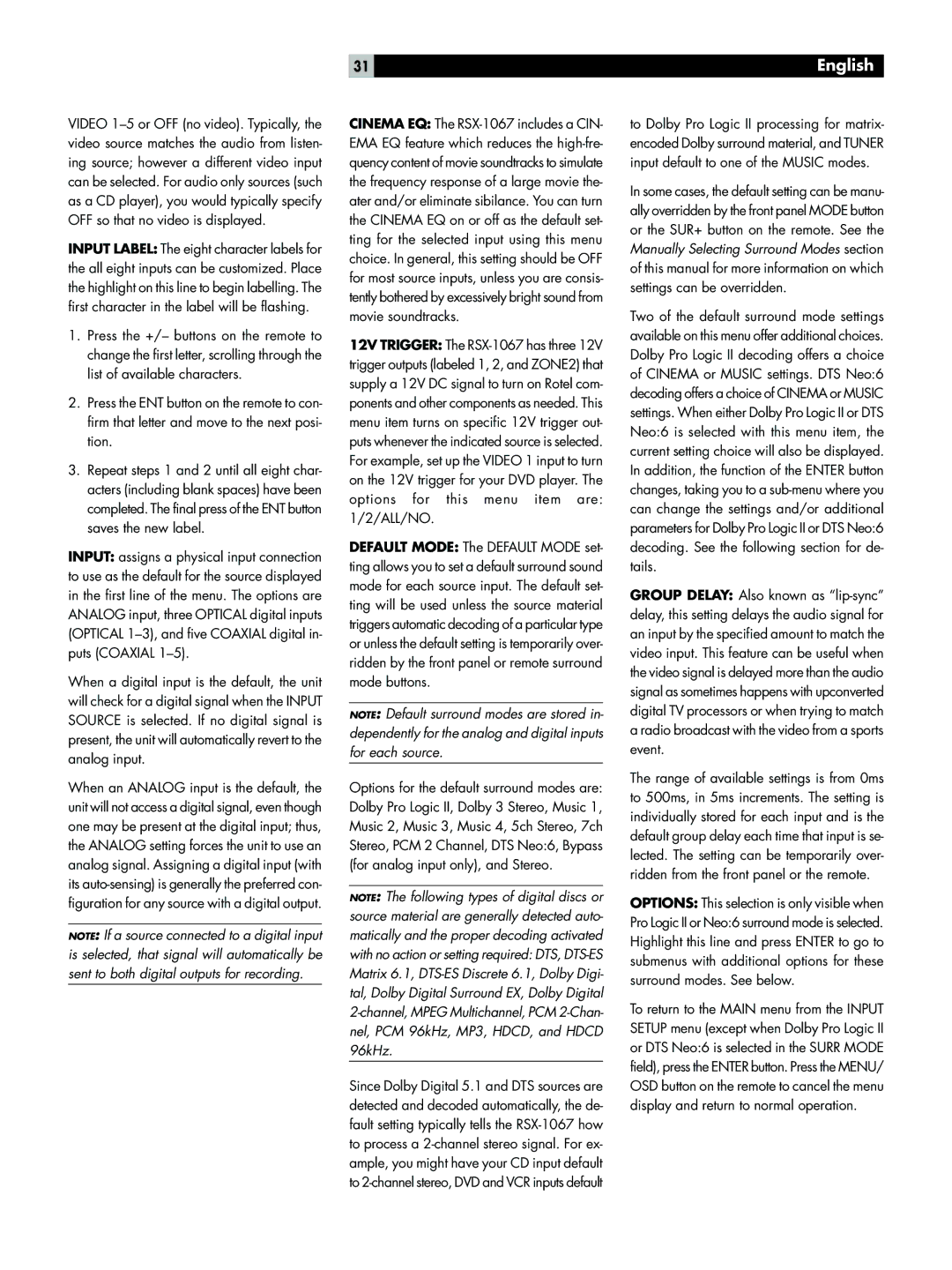
31 | English |
VIDEO
INPUT LABEL: The eight character labels for the all eight inputs can be customized. Place the highlight on this line to begin labelling. The first character in the label will be flashing.
1.Press the +/– buttons on the remote to change the first letter, scrolling through the list of available characters.
2.Press the ENT button on the remote to con- firm that letter and move to the next posi- tion.
3.Repeat steps 1 and 2 until all eight char- acters (including blank spaces) have been completed. The final press of the ENT button saves the new label.
INPUT: assigns a physical input connection to use as the default for the source displayed in the first line of the menu. The options are ANALOG input, three OPTICAL digital inputs (OPTICAL
When a digital input is the default, the unit will check for a digital signal when the INPUT SOURCE is selected. If no digital signal is present, the unit will automatically revert to the analog input.
When an ANALOG input is the default, the unit will not access a digital signal, even though one may be present at the digital input; thus, the ANALOG setting forces the unit to use an analog signal. Assigning a digital input (with its
NOTE: If a source connected to a digital input is selected, that signal will automatically be sent to both digital outputs for recording.
CINEMA EQ: The
12V TRIGGER: The
DEFAULT MODE: The DEFAULT MODE set- ting allows you to set a default surround sound mode for each source input. The default set- ting will be used unless the source material triggers automatic decoding of a particular type or unless the default setting is temporarily over- ridden by the front panel or remote surround mode buttons.
NOTE: Default surround modes are stored in- dependently for the analog and digital inputs for each source.
Options for the default surround modes are: Dolby Pro Logic II, Dolby 3 Stereo, Music 1, Music 2, Music 3, Music 4, 5ch Stereo, 7ch Stereo, PCM 2 Channel, DTS Neo:6, Bypass (for analog input only), and Stereo.
NOTE: The following types of digital discs or source material are generally detected auto- matically and the proper decoding activated with no action or setting required: DTS,
Since Dolby Digital 5.1 and DTS sources are detected and decoded automatically, the de- fault setting typically tells the
to Dolby Pro Logic II processing for matrix- encoded Dolby surround material, and TUNER input default to one of the MUSIC modes.
In some cases, the default setting can be manu- ally overridden by the front panel MODE button or the SUR+ button on the remote. See the Manually Selecting Surround Modes section of this manual for more information on which settings can be overridden.
Two of the default surround mode settings available on this menu offer additional choices. Dolby Pro Logic II decoding offers a choice of CINEMA or MUSIC settings. DTS Neo:6 decoding offers a choice of CINEMA or MUSIC settings. When either Dolby Pro Logic II or DTS Neo:6 is selected with this menu item, the current setting choice will also be displayed. In addition, the function of the ENTER button changes, taking you to a
GROUP DELAY: Also known as
The range of available settings is from 0ms to 500ms, in 5ms increments. The setting is individually stored for each input and is the default group delay each time that input is se- lected. The setting can be temporarily over- ridden from the front panel or the remote.
OPTIONS: This selection is only visible when Pro Logic II or Neo:6 surround mode is selected. Highlight this line and press ENTER to go to submenus with additional options for these surround modes. See below.
To return to the MAIN menu from the INPUT SETUP menu (except when Dolby Pro Logic II or DTS Neo:6 is selected in the SURR MODE field), press the ENTER button. Press the MENU/ OSD button on the remote to cancel the menu display and return to normal operation.
